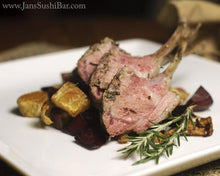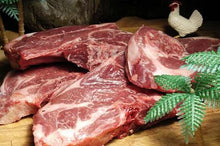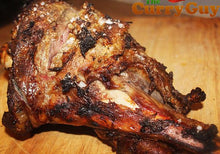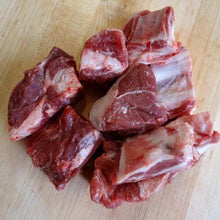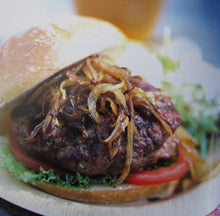Delicious Chevron & Cabrito Goat Meat
Grande Premium Meats
Regular price
$ 165.95
Sale
6 Pound Minimum
Three quarters of the world's population eats goat meat. This trend is rising in the United States as well. Goat is surprisingly healthy compared to the usual meats we consume, even chicken! Goats are quickly becoming a common sight along roadsides and on small farms all over the United States. Beef, chicken, and pork are more widely consumed at the American family dinner table so many people are surprised to learn that goat is actually the world’s most popular meat.
The nutritional value of goat meat depends primarily on the way it is prepared and how big the serving size is. A 4 oz. cooked serving of goat meat has 124 calories. There are 2.6 grams of fat, 0.8 grams of saturated fat, 25 grams of protein and 64 mg of cholesterol in this serving.
Comparisons
Goat meat is lower in fat than chicken, but higher in protein than beef. Goat meat outshines traditional meat sources in most areas: it's lower in calories, total fat, saturated fat and cholesterol. The low levels of saturated fat and cholesterol, combined with its high iron and protein content, make goat meat a good choice for anyone looking for a healthy red meat. It's a leaner, healthier choice when compared to equal serving sizes of chicken, beef and pork.
Cooking Goat (From Off the Grid News, Sally G.)
Cooking goat the right way isn’t rocket science. There is a bit of a knack to doing it, but you don’t have to go to culinary school to get the knack. Instead, just follow these ten tips for cooking with goat to ensure delicious, tender dishes every time.
1. Be smart with your butchering and purchases
Getting the right meat at the start will help you serve up a great meal. You want to aim for goat meat from young goats (six to twelve months old) whenever you can. As goats age, their meat becomes tougher. If you must use meat from older goats, watch out for butchering females in heat, as their meat will be very tough. (To-Table's goat is the younger, more tender goat).
2. Give yourself plenty of time
Goat meat is more tender and flavorful if it is cooked slowly. Rushing to whip up a meal will leave you with a tougher end product, and it also increases the chances that you’ll dry out the meat. When it comes to goat, think slow roasts, long simmers, or a day stewing in the crockpot.
3. Turn down the heat
As a lean meat, goat can dry out quickly at high heat, stripping it of flavor and tenderness. Turn down the heat and cook it more slowly to lock in flavor and ensure a smooth, tender finish for the meat.
4. Hold the salt
It’s almost instinctive to salt meat on its way into the pan, but you don’t want to do that with goat. Salt draws the juices of the meat to the surface, making it more likely that you’ll end up with dried-out goat meat by the time you’re done.
More Practical Information on Self-Reliant Living…
5. Marinades matter
If you’re planning to roast or grill your goat meat, you will quickly find out that marinades do matter! Many people read recipes that call for overnight marinades and think an hour or two will cut it. Not true! A good long marinade is a real blessing of flavor, moisture, and tenderness for goat meat.
6. Baste away
Basting is another trick to keep goat meat moist throughout the cooking process. You can either save some of your original marinade or make up a light olive oil and butter baste to lock moisture in without significantly altering the taste of your dish.
7. Feel free to add fat
Adding fat to goat meat will help it stay tender and moist, particularly if you are cooking ground goat in a skillet or frying up steaks. A bit of olive oil, avocado oil, lard, or bacon fat will do the trick.
8. Consider covers and wraps
Covered dishes and wrapped meat preparations will protect your goat and lock in moisture. Simmering with a cover or roasting in an oven bag can make a big difference in the final taste. When grilling, you may also want to use a foil tray under kebabs to help collect the juices, giving you instant basting sauces and preventing dried-out or tough kebabs.
9. Watch it carefully as it finishes
When it comes to burgers, steaks, and other small cuts of goat, the finishing minutes can be critical. Goat’s lean nature makes it finish more quickly than beef or chicken, so it can be easy to overcook, particularly when you aren’t looking at a lengthy cook time. Watch it closely and consider turning down the heat for the end of the process to ensure a smooth finish for your meal.
10. Let it rest
Last but not least, let your goat rest. Like all other meats, the proteins set during cooking and push moisture to the middle of the cut. Letting the meat set will help the juices redistribute themselves so that you have a moister and more tender cut, something especially important for meats that can dry out like goat. Thus, after cooking, place your goat on a warm plate and cover it with foil to rest. Steaks and burgers should rest two to five minutes, while a roast should rest about fifteen minutes before serving.
Rich Forrest - Owner of Grande Premium Meats

Del Norte - Colorado






